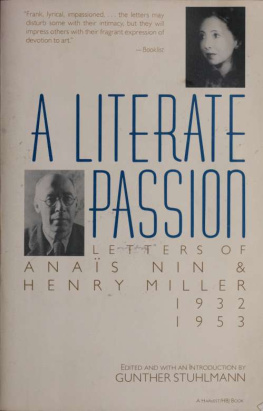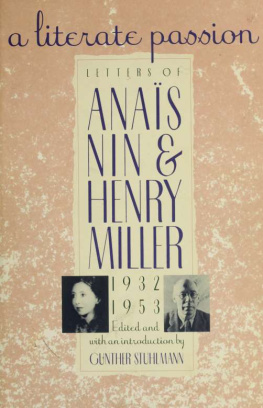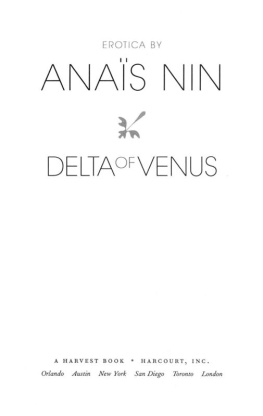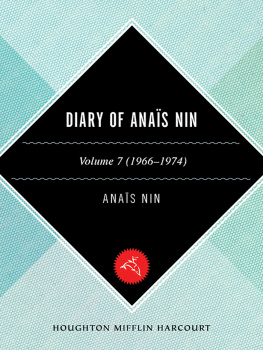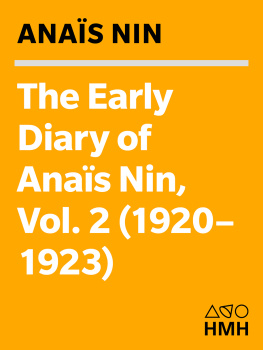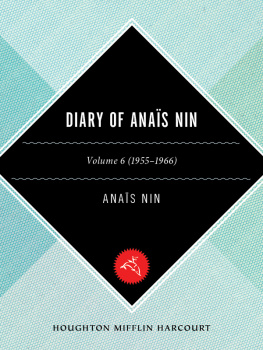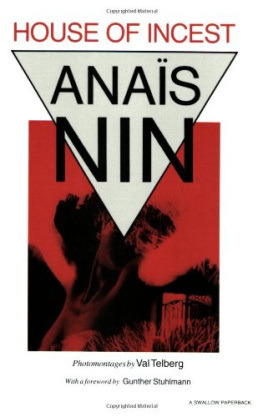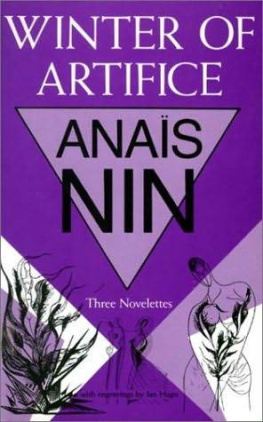A Harvest/HBJ Book
Harcourt Brace Jovanovich, Publishers
San Diego New York London
Copyright 1969 by Anas Nin
Preface copyright 1969 by Gunther Stuhlmann
All rights reserved. No part of this publication may
be reproduced or transmitted in any form or by any
means, electronic or mechanical, including
photocopy, recording, or any information storage
and retrieval system, without permission in writing
from the publisher.
Requests for permission to make copies of any part of
the work should be mailed to: Permissions Department,
Harcourt Brace Jovanovich, Publishers,
Orlando, Florida 32887.
Library of Congress Catalog Card Number: 66-12917
ISBN 0-15-626027-1 (Harvest/HBJ : pbk.)
Printed in the United States of America
L M N O P Q R
Preface
Anas Nin, we learn from her gradually unfolding Diary, has had to come to terms with America, with the experience of a "new world" as it were, several times in her life. Each time this encounter took place at a different stage in her own development. Each time it produced a response, a reflex, that had far-reaching consequences both for her life and for her art.
The Diary itself, Miss Nin's basic stance vis--vis the world, had its origin in her first journey to the United States. Her ultimate choice, two decades later, between the profession of psychoanalysis and her commitment to writingbetween a "life of action" and a "life of the senses," as she phrased itwas triggered by her New York experiences, as we have seen in the second published volume of the Diary. The present volume is the record of her third crucial confrontation with the New World, dining the difficult years of the early 1940's, which eventually determined her career as a writer.
When Miss Nin arrived in New York for the first time, at the age of eleven, with her mother and her two younger brothers, she was not prepared to share the unsettling immigrant experience of so many of her fellow passengers. America, she had been led to believe, represented merely a "temporary" dislocation. The painful separation from her beloved father, the celebrated Spanish composer and pianist, Joaquin Nin, was to be of short duration. In the notebooks she had begun during the lengthy passage from Barcelona on the S.S. Montserrat, as a "letter" to her father, she anticipated an early resumption of the enchanted life in his orbit that had been disrupted, inexplicably to her, by a family crisis. So she stepped ashore clutching her brother's violin casea symbol, perhaps, of her "artistic" pastproclaiming visibly her distinction from those who had obviously come to embrace a new life, to start out, again, as "Americans."
New York, the sprawling, angular hub of what was then a provincial frontier country, presented a sharp contrast to the tree-lined, residential charm of Paris, where she had been born. It offered none of the mellow grace of Brussels, Arcachon or any of the Old World places her father's virtuoso career had previously taken the family. Settling into the dreary middle-class gentility of Manhattan's West Side, attending a Catholic school, where she was made conscious of the peculiarities of her newly acquired English, or being exposed to the sweatily proletarian boardwalk in Coney Islandall these manifestations of "American" life compared rather unfavorably with her memories of Europe. "I would prefer to return to Barcelona," she confided to one of her early notebooks. "I hate school. I hate New York. It is always noisy, everything is somber, shut-in, severe." As a transient stranger, she also felt ambiguously isolated. "I make no friends and the reason is this: One is never sure to stay anywhere."
Clinging to the hope of an eventual release from her American exile, obedient to her mother, the young Anals earnestly tried to cope with the new environment. But after an uncomfortable year in New York, a terrible realization began to dawn on her: "The veil is torn and I must tell myself: Father is never coming back. Now a thousand things I did not understand become clear. I forgive Mother for deceiving us, letting us believe Father had not gone away forever. She did not want to destroy our youth with tragedy. But now I find reality more terrible as I was not prepared for it."
The loss of her father, this central, traumatic experience of Miss Nin's youth, which was to haunt her for so many years (as we have seen in the two previously published Diary volumes), perforce also heralded a significant change in her own status. The return to Europe, to the familiar, aristocratic Bohemia of her father, had definitely been cut off. Now truly "displaced," she regarded herself as an odd, precocious "foreigner" amidst her American contemporaries, whose formative backgrounds, ambitions and expectations she did not share. "Why," she asked her budding Diary, "am I not like everybody?"
"When a child is uprooted," Miss Nin wrote many years later, "it seeks to make a center from which it cannot be uprooted." Her center, as we know, became the monumental Diary she is still keeping today. It served as the confidant of her maturing years, the precious mirror of her intimate self. It turned into the multileveled novel of her life, the ultimate instrument of her art. In New York, she carried the Diary, tucked away in a straw basket, like an astronaut, enduring an alien environment, linked to his life-sustaining survival pack.
Cut off from retreat into the past, except in memory, Miss Nin now embarked upon the exemplary process of pioneering which was to become one of the basic themes in her life. Instead of "giving in," of conforming to the prevailing standards and expectations of American life, or of rejecting them altogether in futile rebellion, she opted for a third alternative. In the midst of the concrete wilderness she began to construct, to preserve, her own "livable" world. It became, essentially, a world of attitudes rather than objects, of personal values rather than abstract ideologies, of aesthetic appreciations rather than material ambitions. Almost instinctively, she grasped for what was perhaps the only workable answer to permanent displacement of any kind: the creation of an intimate, individual world, an "un-uprootable" personal bastion in a fluid, potentially hostile and destructive environment.
Unlike many native-born Americans who never experienced a climate concerned with or even appreciative of cultural values, who first had to "escape back" to Europe, to get away from the "drab sameness"as Brooklyn-born Henry Miller called itof a parochial, materialistic immigrant society, Miss Nin had been brought up in a cosmopolitan world of art. The experience had been firmly implanted in her as a child. It had been preserved, like a treasured icon, in her mother's brownstone in the West Seventies, where Spanish and Cuban artists found a hospitable gathering place. And she herself had rejoined this world, a few years later, by becoming a model, a Spanish dancer, by gaining access, on her own, to those enclaves in New York where other "foreigners"real or imaginedpursued their "foreign" trade of artistic creation. Thus, before Miss Nin returned to France eventually, in the 1920's, she had already re-established, in America, a link, an umbilical cord, to the boundary-transcending world of art and artists which forevermore was to remain her sanctuary on both sides of the Adantic.
When Miss Nin disembarked again in New York, almost twenty years later, in November 1934, she approached the New World in a different mood, as we have seen in the opening section of volume two of the Diary. Her relationship to Americaas that ot post-World War I Europe in generalwas undergoing decided changes. What once had been a remote, obliterating melting pot for the tired masses of Europe was now emerging, in its own right, as the probing ground of a fascinating technology, as a harbinger of a New Era. The advent of better communicationsfaster ships, airplanes, radio, newsreels, the export of American jazz, of Hollywood films, the emergence of a fresh, indigenous literaturehad carried a new Image, a new awareness of the United States to Europe. It was an image of vitality, and vitality, the possibility of growth, the opening of new perspectives, had always attracted Miss Nin.
Next page

